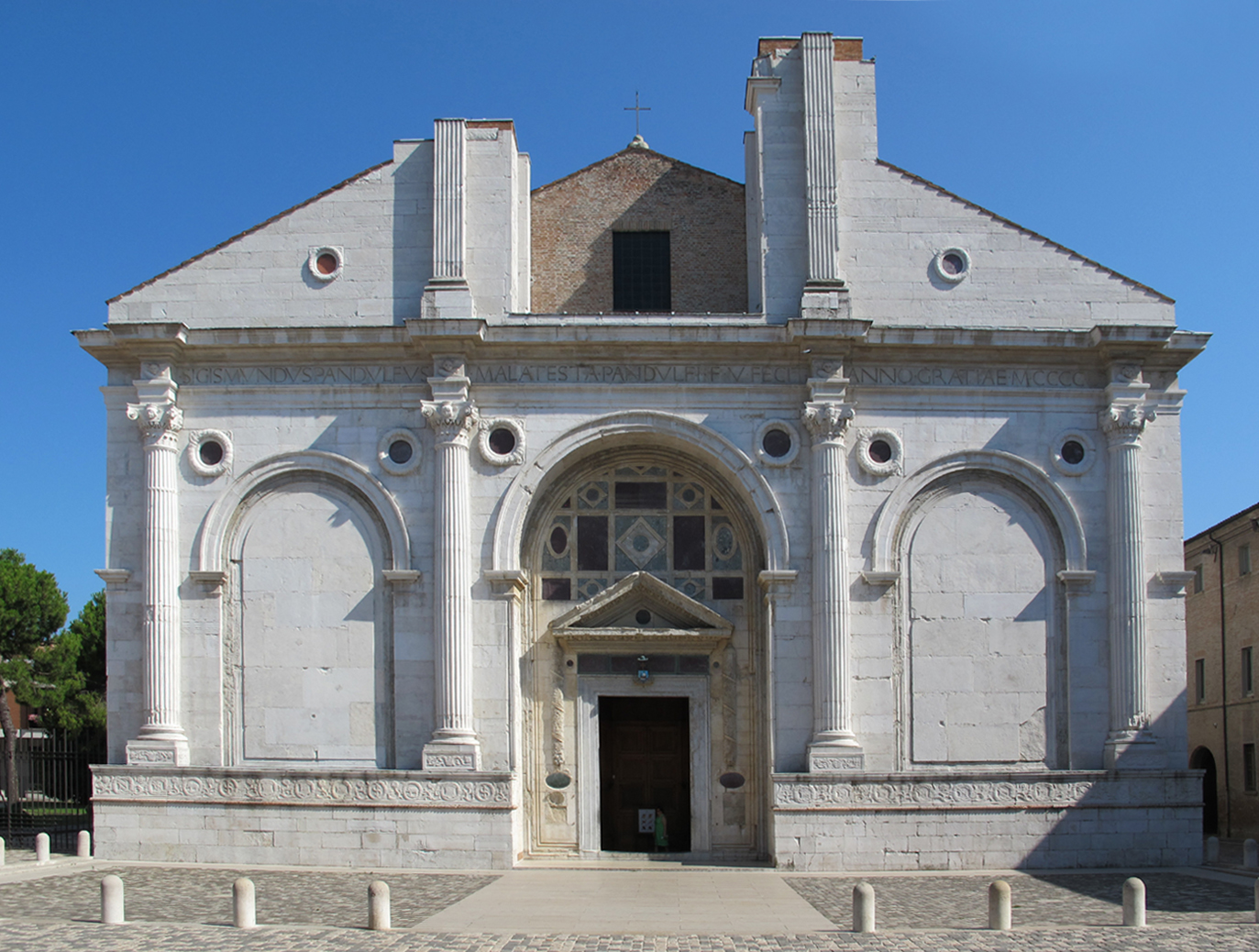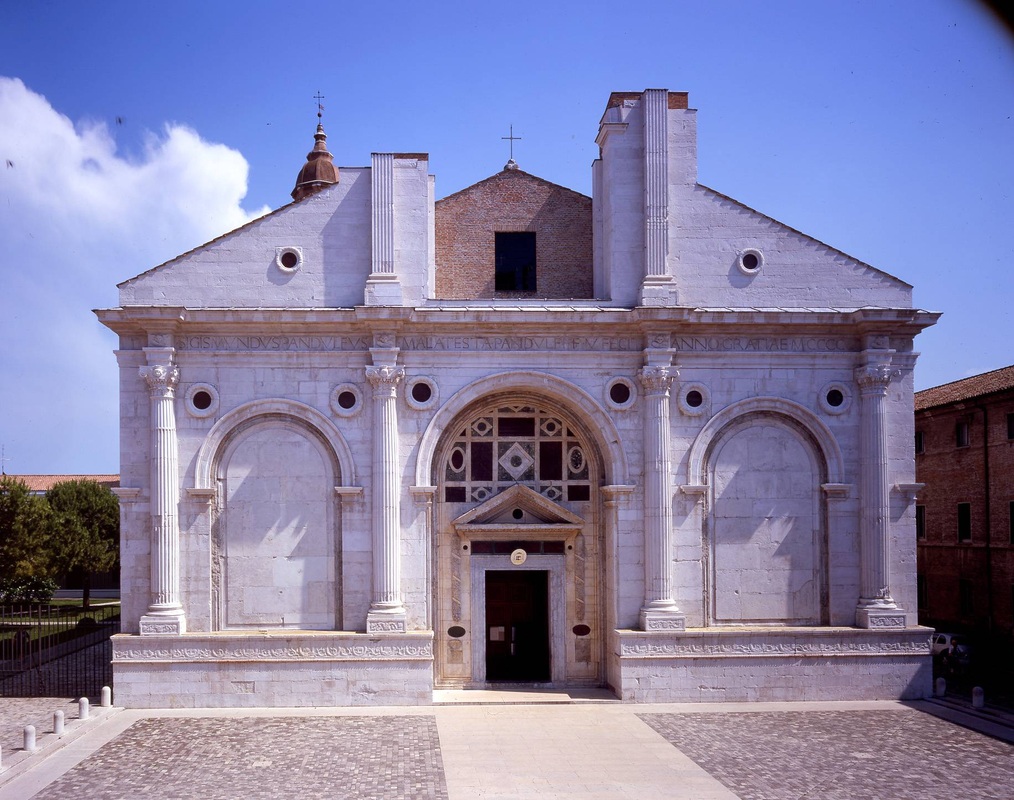
Leon Battista Alberti, Tempio Malatestiano Rimini, 1450 Rimini
Tempio Malatestiano, Cathedral of Rimini is one of artworks by Leon Battista Alberti. Artwork analysis, large resolution images, user comments, interesting facts and much more.. He did not spare the funds of Malatesta and invited to design the temple of Leon to Battista Alberti, who after his death Brunelleschi could be considered the first.

Tempio Malatestiano Façade by ALBERTI, Leon Battista
Leon Battista Alberti (Italian: [leˈom batˈtista alˈbɛrti]; 14 February 1404 - 25 April 1472) was an Italian Renaissance humanist author, artist, architect, poet, priest, linguist, philosopher, and cryptographer; he epitomised the nature of those identified now as polymaths.He is considered the founder of Western cryptography, a claim he shares with Johannes Trithemius.

Tempio Malatestiano a Rimini fotografie
Works Tempio Malatestiano, Palazzo Rucellai, Santa Maria Novella Leon Battista Alberti[1] (February 18, 1404 - April 20, 1472) was an Italian author, artist, architect, poet, priest, linguist, philosopher, and cryptographer, and general Renaissance humanist polymath: though he is often characterized as "architect" James Beck observes,[2] "to.

Pin page
Leon Battista Alberti was a notable Italian architect and humanist, best known as the pioneer instigator of the Renaissance art theory. His intellect, personality and influential treatises have led to establish him as the prototype of the Renaissance "Universal man". Leon Battista Alberti was born on February 14, 1404 in Genoa, Italy, as.

Tempio Malatestiano, Leon Battista Alberti, Rimini, 1453 Architettura
Malatesta hired architect Leon Battista Alberti to build a mausoleum for himself and his wife, Isotta degli Atti. The result was an elaborate and highly decorative monument to this couple, whose initials are emblazoned all over the Tempio Malatestiano. These changes were particularly detested by Pope Pius II, who virulently condemned them.

Leon Battista Alberti. Facade and flank, S. Francesco (tempio
Leon Battista Alberti ( Italian: [leˈom batˈtista alˈbɛrti]; 14 February 1404 - 25 April 1472) was an Italian Renaissance humanist author, artist, architect, poet, priest, linguist, philosopher, and cryptographer; he epitomised the nature of those identified now as polymaths. He is considered the founder of Western cryptography, a claim.

CategoryTempio Malatestiano Facade Facade, Architecture, Barcelona
Italie. Coordonnées. 44° 03′ 36″ N, 12° 34′ 13″ E. modifier - modifier le code - modifier Wikidata. Le temple Malatesta ou temple de Malatesta (en italien : Tempio Malatestiano) est le nom communément donné à la cathédrale de Rimini, portant le titre de Santa Colomba. Il abrite les tombeaux de la famille de Sigismond Malatesta .

Tempio malatestiano, ri, facciata, capitello Leon Battista Alberti
Tempio Malatestiano, burial chapel in Rimini, Italy, for Sigismondo Pandolfo Malatesta, the lord of the city, together with his mistress Isotta degli Atti and the Malatesta family.. 1446, from the Gothic-style Church of San Francesco according to the plans of the Early Renaissance Florentine architect Leon Battista Alberti. Construction was.

Tempio Malatestiano Façade by ALBERTI, Leon Battista
Malatesta Temple - Tempio Malatestiano. The Malatesta Templ e, Cathedral of the diocese since 1809, is a famous example of Renaissance architecture and maybe the most illustrious monument of Rimini. It was built by Leon Battista Alberti as a precious marble casket around the gothic church of St. Francis. The work, wanted by Sigismondo.

17. Templo Malatestiano o San Franciso de Rimini. Remodelación
Tempio Malatestiano. Alberti received the commission to design the Tempio Malatestiano from nobleman Sigismondo Pandolfo Malatesta who intended it to serve as a mausoleum and testament to his love for his future wife,. Battista Alberti (Leon was the name he adopted in later life) was the second (after Carlos) of two illegitimate children.

Leon Battista Alberti, il Tempio Malatestiano 145054
The facade of the Tempio Malatestiano church in Rimini. It was designed by the Italian Renaissance architect Leon Battista Alberti (1404-1472 CE). Mid-15th century CE. Its design is influenced by the triumphal arch of ancient Rome.

Leone Battista Alberti Tempio Malatestiano.jpg Sztuka renesansu
The Tempio Malatestiano ( Italian: Malatesta Temple) is the unfinished cathedral church of Rimini, Italy. Officially named for St. Francis, it takes the popular name from Sigismondo Pandolfo Malatesta, who commissioned its reconstruction by the famous Renaissance theorist and architect Leon Battista Alberti around 1450.

Leon Battista Alberti Tempio Malatestiano (EN Malatesta Temple
Il Tempio malatestiano, usualmente indicato dai cittadini come il Duomo e dal 1809 divenuta cattedrale col titolo di Santa Colomba, è il principale luogo di culto cattolico di Rimini.Rinnovato completamente sotto la signoria di Sigismondo Pandolfo Malatesta, con il contributo di artisti come Leon Battista Alberti, Matteo de' Pasti, Agostino di Duccio e Piero della Francesca, è sebbene.

Pin di Nicola su Arte Architettura, Arte, Architetti
The Tempio Malatestiano is the unfinished cathedral church of Rimini, Italy. Officially named for St. Francis, it takes the popular name from Sigismondo Pandolfo Malatesta, who commissioned its reconstruction by the famous Renaissance theorist and architect Leon Battista Alberti around 1450.

Rimini, Tempio Malatestiano Rimini italy, Rimini, Italy
Applying Classical arithmetic techniques to analyze Alberti's Tempio Malatestiano, this paper demonstrates that its design corresponds to Alberti's system based on geometrical features of the cube depicting 'natural relationships that cannot be defined as numbers'.. Leon Battista Alberti: On the Art of Building in Ten Books, The MIT.

Alberti's Work LEON BATTISTA ALBERTI
Leon Battista Alberti (1404-1472 CE) was an Italian scholar, architect, mathematician, and advocate of Renaissance humanism.. Tempio Malatestiano, Rimini by Alberti. Michele1978rimini (Public Domain) In Mantua, Alberti designed two churches of note, San Sebastiano in 1460 CE and the Basilica of San Andrea c. 1470 CE (construction began in.